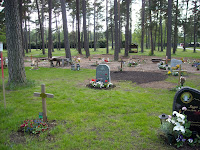 The right to live...and to die with dignity is an issue of critical dimension that continues to challenge those in power to act not simply out of humane considerations but in accordance with the law. Life is sacred as all religions declare and precious in the name of everything that is good in humanity.
The right to live...and to die with dignity is an issue of critical dimension that continues to challenge those in power to act not simply out of humane considerations but in accordance with the law. Life is sacred as all religions declare and precious in the name of everything that is good in humanity.In Sweden, the right to end one's life - of persons whose daily sustenance comes mainly from tubes attached to machines, has been a long-standing debate in the medical, as well as political communities. There are a number of cases that came to light in the media where certain individuals have been kept alive for many years through palliative care, who have no hopes of ever getting better and where pain and suffering get worse as days pass. They have expressed the desire to die, or be allowed to die. It is often an agonishing familymember who plead with the physician for suicide help.
Recently the case of a person who has been kept articifially alive was brought to court and challenged the National Health Board - the highest Swedish decisionmaking body, to make a decision to grant the right to die.
The outcome may have favoured one particular case but the issue on granting one's desire to die with dignity has yet to become legally acceptable.
There are complicating factors that do not allow a simple legal interpretation of one's right to die with dignity. There are many cases where the person no longer have the capacity to express the will to die, so that it is the family that interprets that will. If there is no written testament to the effect that the person concerned has infact stated the will to end his life or be allowed to die with dignity, then it would be the words of living relatives that have to be validated. Are those words expressed out of selfless love or are they motivated by interests other than those of the person lying in a comatose condition.
Persons living less than half a-life or hanging to the barest thread of life for many years in hospitals are more visible to a greater number of people who are part of the medical and nursing staff. There are however, less visible cases who are in long-term nursing homes who may or may not be palliative cases. There is one particular case where I have had professional experience in nursing. She had been a well-known personality in the academic community and had authored books. A severe stroke caused by the death of her husband sent her to into a state of helpless immobility. She had to be fed through a tube in her stomach. But she was conscious of everything around her and she reacted to music, people around her, things of beauty like nature when she is taken out in the park.
One summer day, the nursing staff was informed that the woman's children wanted their mother to end her life because according to them, it was her expressed desire not to go on living. This was a most unusual situation and most of those involved in the caring work did not immediately comprehend the depth of this case, nor did many understand that it was going to be a difficult ethical and moral dilemma for all those involved in looking after her.
It dawned on some after some days that their religion could not accept being a part of an assisted self-suicide case. Such individual protests were muffled and those with psychological problems in dealing with the day-to-day care of the woman were advised to see a psychologist.
It took a month for this person to finally die and during all those days, she was deprived of food and was only given water and morphine. She could not talk, but her face spoke of the pain and anguish she was going through. This case shattered the morale of the people working in the unit and sent several on sick leave from psychological breakdown. The working morale of the staff hit the bottom and much later came a reorganisation of the unit itself. What was inconceivable in this case was how the highest leadership of this organisation agreed to let this happen when the law forbids assistance in self-suicide.
While the issue of the right to die with dignity remains a bone of contention, there are less visible cases going on in the less exposed nursing homes, where so-called palliative cases are found. In general they are cases of persons who are extremely sick, who are just waiting for their time to go. They get the care they need in terms of food, quietude and company though not of medicine. But who really knows what goes on in many nursing homes.#
